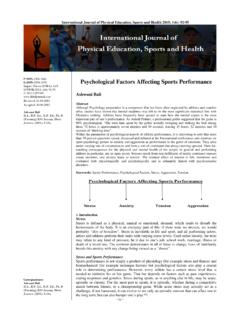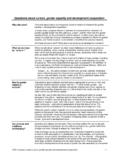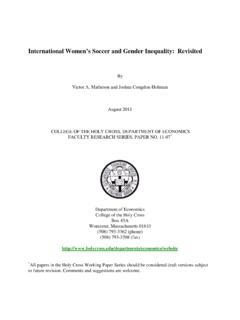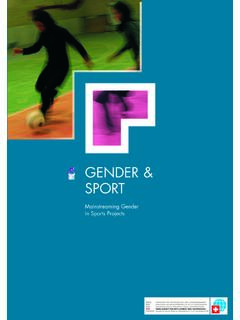Transcription of P-ISSN: Gender discrimination in sports
1 ~ 545 ~ International Journal of Physical Education, sports and Health 2016; 3(3): 545-547 P-ISSN: 2394-1685 E-ISSN: 2394-1693 Impact Factor (ISRA): IJPESH 2016; 3(3): 545-547 2016 IJPESH Received: 14-03-2016 Accepted: 15-04-2016 Dr. Vishwas Manohar Deshpande , Physical Education Dr. Umathe Arts, Science & R. Mokhare Commerce College Nagpur, Maharashtra, India. Correspondence Dr. Vishwas Manohar Deshpande , Physical Education Dr. Umathe Arts, Science & R. Mokhare Commerce College Nagpur, Maharashtra, India. Gender discrimination in sports Dr. Vishwas Manohar Deshpande Abstract Gender discrimination in the athletics industry has long been a controversial topic even the founder of the modern Olympics, Baron Pierre de Coubertin, said in 1896, No matter how toughened a sportswoman may be, her organism is not cut out to sustain certain shocks.
2 Since then, Gender equality in sports has come a long way, including UNESCO recognizing sports and physical activity as a human right in 1978. Despite the obstacles women face in athletics, many women have led and are leading the way to Gender equity. This paper profiles women athletes and administrators who have paved the way, and offers "Strategies for Change" that women and girl athletes, coaches, administrators, and parents can take to make school and college athletics more equitable. Participation in sports benefits women just as it does men, helping to develop leadership skills, boosting self-esteem and grades, and promoting physical fitness and health. Women and girls who participate in sports and fitness programs are healthier and more academically successful.
3 But the emphasis in college on "superstar" male athletes ignores the health and well-being of all students in favour of creating a few profitable athletes. In addition, male athletes in certain sports are taught to de-humanize and degrade women as part of their sports training. This in turn can lead to increased violence against women by these male athletes. We need to create a climate in which sports and fitness are for everyone, not just a few, and in which everyone's abilities are tested and respected. Keywords: Gender discrimination , self-esteem, Gender equality , leadership skills, fitness, male athletes Introduction Sport has been a part of the official school program since the mid-1800s, and was originally incorporated into the curriculum to serve as an important line of defense against the potential feminization of American males by a growing female teaching profession.
4 As a part of the curriculum, sport provided opportunities for physical fitness and competition, as well as a medium through which valued socio-cultural life skills could be learned and practiced. Grounded in ideals of masculinity, sport, more than any other part of the educational curriculum has been, and continues to be, a Gender issue. Aim of Study This paper will explore how school sport has served to institutionalize a Gender specific and Gender biased sport value system. First the socio-cultural context, in which school sport emerged, and its history and evolution will be reviewed. Next the differential impact which school sport has on females and males will be examined. Objectives To promote Gender equality . To empower women and girls through sports .
5 equality in society and sports To decrease the high dropout rate of women and girls Hypothesis The paper hypotheses that the development of school sport has over time, marginalized and devalued women's sport, and the women who participate. It is suggested that because of this, sport participation by women and girls has actually been suppressed. ~ 546 ~ International Journal of Physical Education, sports and Health Socio-Cultural Issues The issue of Gender equality in sport is as old as sport itself. Strides have been made, but sport remains an institution dominated by men. Women's sport has been defined and shaped by "..men's values, men's understanding of the world, and men's experiences-all of which suppress the development and expression of female values.
6 " The history and evolution of gendered sport cultures substantiates this statement and provides evidence, not only of historic and existing Gender bias in sport, but of a sport culture created and sustained to nurture that bias. Historically, women and girls have not been provided equal opportunities in sport because of (a) perceptions relative to physiological differences between the sexes, (b) societal norms and attitudes, and (c) organizational rules and support. In the early 1900s, medical doctors and female physical educators thought that vigorous activity would endanger a woman s reproductive capacities as well as result in the development of "unsightly" muscle. In response to these concerns, early sport endeavors for women and girls were limited to activities such as archery, dancing, croquet, golf, swimming, and tennis.
7 More recent and ongoing research has shown that there are no medical, mental, or emotional reasons that support the restriction of women/girls from participating and competing in sport. In the early 1970s, two events occurred that dramatically altered the course of sport for women and girls. In 1971, the Association for Intercollegiate Athletics for Women (AIAW) was created by female physical educators as a "..model of athletic governance designed for female student-athletes, which incorporated the prevailing women's sports philosophy". Gender discrimination School girls everywhere are made to believe that wherever they go, they can be just as smart, athletic and successful as boys. However, the story is not the same in reality. From the moment they are born, girls are forced to realize that even instances wherein only talent and passion are the quintessential distinguishers, they are still to be inferior to their male counterparts.
8 Unsurprisingly, sports , which house the careers of the most passionate and the aspiring, is also a major concern when it comes to the issue of Gender discrimination . Male dominance in sports has become a nightmare for female athletes, who in the hope of pursuing their careers in the field of sports , have been deprived of self-esteem among a plethora of Gender discrimination instances. Women s participation in sports has a long history. It is a history marked by discrimination , but also one that is filled with major accomplishments by female athletes and important advances for Gender equality . Among many, some of the most notable achievements of women in sports are those of Helene Madison of the United States of America, the first woman to win the 10-yard freestyle in one minute at the 1932 Olympics, Maria-Teresa de Filippis of Italy, the first woman to compete in a European Grand Prix auto race in 1958, and Tegla Loroupe of Kenya, who in 1994 became the first African woman to win a major marathon.
9 These achievements were made in the face of numerous barriers based on Gender discrimination . Also, women are often perceived as being too weak for sport, particularly endurance sports like marathons and weightlifting. Most people still hold the belief that sports are harmful to women s health, particularly to their reproductive health. Title IX Passed in 1972, Title IX was a landmark piece of legislations that banned sexual discrimination in all schools, including in athletics. It applies to all state and local agencies that receive education funds, which includes school districts, colleges, universities, libraries and museums. It focuses on giving women equal opportunities in the athletic arena to those of men. Women as Coaches and Athletic Administrators There are still significantly fewer women coaches and administrators than men coaches and administrators.
10 One reason is that as the salaries of coaches of women's teams increased with Title IX, male coaches began to displace female coaches. In 1972, the year Title IX was signed into law, over 90% of women's teams were coached by women. Today, half of women's college teams are coached by men, but only about 2% of men's teams are coached by women. The record is not much better at secondary schools. As of 1990, over 40% of girls' teams were coached by men, but only 2% of boys' teams are coached by women. Seventy-five percent of all high school teams were coached by men. Women are also excluded from administrative positions within sports . Only 21 % of college women's athletic programs are headed by women, and women fill only 33% of all administrative jobs in women's programmes.











